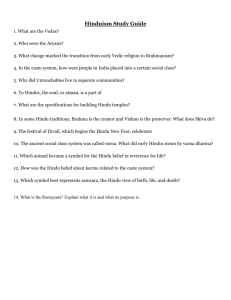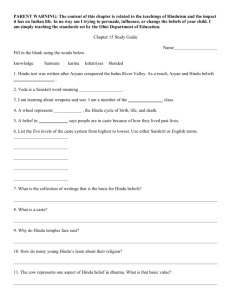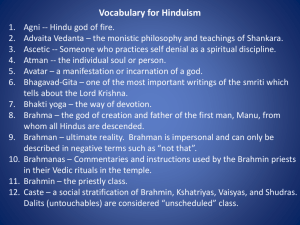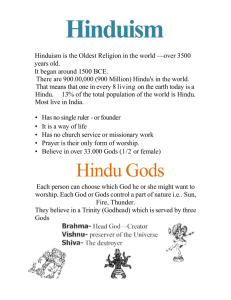Unit 9a: Hindu Texts--Societal Implications Objectives Be aware of the following
advertisement
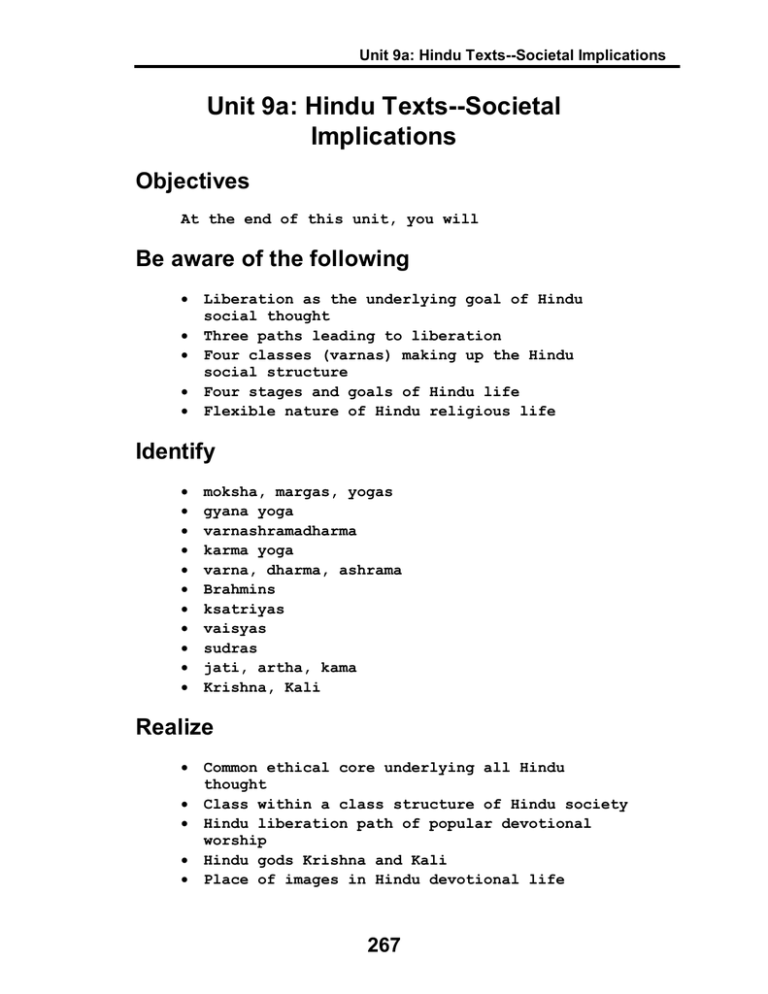
Unit 9a: Hindu Texts--Societal Implications
Unit 9a: Hindu Texts--Societal
Implications
Objectives
At the end of this unit, you will
Be aware of the following
• Liberation as the underlying goal of Hindu
social thought
• Three paths leading to liberation
• Four classes (varnas) making up the Hindu
social structure
• Four stages and goals of Hindu life
• Flexible nature of Hindu religious life
Identify
•
•
•
•
•
•
•
•
•
•
•
moksha, margas, yogas
gyana yoga
varnashramadharma
karma yoga
varna, dharma, ashrama
Brahmins
ksatriyas
vaisyas
sudras
jati, artha, kama
Krishna, Kali
Realize
• Common ethical core underlying all Hindu
thought
• Class within a class structure of Hindu society
• Hindu liberation path of popular devotional
worship
• Hindu gods Krishna and Kali
• Place of images in Hindu devotional life
267
Unit 9a: Hindu Texts--Societal Implications
Unit 9a: Hindu Texts--Societal
Implications
"'Thou shalt love thy neighbor as thyself'-because thy neighbor is thyself; God is in both thee
and thy neighbor, and both are in God. He who acts in
this spirit need not fear that his acts will bind him
to further existence."
--Franklin Edgerton, The Bhagavad Gita, p. 165.
The close alliance of Hindu thought and practice
(belief and ethics) makes it difficult to neatly
categorize aspects of its ethical system. This section
focuses on the margas or paths taken to liberation;
aspects of the varnashramadharma (vahrn-AHSH-rah-muhDAHR-muh) system as a model for society; and the Bhakti
(BUK tee) path.
The Hindu Social Vision
Underlying the whole Hindu
social system is the focus upon
liberation (moksha.) The question
"How can we seek liberation and still
focus on the welfare of society?"
becomes primary.
Three paths (margas), the yogas ('YOH-guhs,'
disciplines, techniques, 'yokes') of knowledge, action
and devotion, mark the ways to liberation. Each path,
like spokes on a wheel, is considered on an equal par
with the others.
Ethics becomes a matter of following the
disciplines or duties involved in your chosen path, a
“living up to the system.”
Underlying each path is a common ethical core
which advocates self-control, non-violence,
truthfulness, self-discipline, cleanliness and
contentment. Hindus practice all three of these paths,
just in differing degrees.
268
Unit 9a: Hindu Texts--Societal Implications
Only when you talk to a person do you find out
what degree of each he or she practices.
1. Gyana yoga
(jnana/gnana/yana) This path of
knowledge is a difficult way, reserved for a select
few. It requires a rare combination of rationality and
spirituality.
Based upon the
Upanishads, it focuses
upon interior knowledge
and meditation.
2. Karma yoga
The path of Karma yoga, that of works or deeds, is
the practice of many Hindus. Varnashramadharma
describes the karma yoga model. Dharma (DAHR muh-social and religious duty) depends on which varna
(VAHRN-ah--social class) one is born into and what
ashrama (AHSH ruh-muh--stage of life [student,
householder, forest dweller, homeless wanderer]) one is
in.
a. Varnas (VAHRN ahs) Four classes (varnas) make
up this model for the social structure.
(1) Brahmins (BRAH mihns) are the guardians of
spiritual values, the religious teachers and priests.
A required twelve years of study acquaints
practitioners with the ritual and practice of this
class.
(2) Ksatriyas (KSHAT ree ahs)--rulers and
warriors--oversee the land or kingdom. Eight years of
study are necessary for members.
(3) Vaisyas (VIS yahs), the merchants, control
cash, agricultural produce and livestock. Vaisyas
require four years of study.
(4) Sudras (SOO drahs) are serfs accorded
service positions, being members of the lowest class.
269
Unit 9a: Hindu Texts--Societal Implications
Within the varna structure,
every work, movement and exercise
in living out the duties of the
class one was born into becomes an
exercise moving toward
enlightenment.
In reality, rather than the varna (class) system,
jati (or class within a class) becomes the decisive
factor in societal relations. Hundreds to thousands of
these classes within the four major varnas divide
society.
Rigid adherence to prohibitions and privileges
within the jati structure is the present-day norm.
With contentment, patience and whole-hearted
concentration, one focuses on his or her duties.
b. Ashrama Hindu response to the question “When
should I do what?” lies in contentedly practicing the
ashrama ('AHSH-ruh-muh,' four stages--student,
householder, forest dweller, homeless wanderer) of
life.
The ideal for a student is to
follow a dedicated regimen of
ascetic and scholarly practice
under the tutorship of a guru.
Householdership becomes a key stage in the whole
system. Responsibilities to family, vocation and
community occupy most of one's attention. Then, at age
sixty, a householder may escape to the forest. In this
guilt-free, hermit stage of retirement, one seeks selfunderstanding and spiritual vision. The last stage,
that of renunciation (being a homeless wanderer),
describes one who neither hates nor loves anything,
someone who lives as identified with the eternal self.
270
Unit 9a: Hindu Texts--Societal Implications
c. The Four Goals The doctrine of the four goals
of life answers the questions “What should I do? What
are legitimate things to follow?” In a sense, these
goals serve in conjunction with the stages of life
described above.
(1) Artha (ahr-tah) Earning wealth, and
economic/political activity, defines artha the first
goal.
(2) Kama
describes pursuit
those of romantic
sensual appetites
(KAH-muh), the second goal,
of sensual pleasures, especially
ecstasy. Cultivating aesthetic and
becomes the objective.
(3) Dharma The third goal, dharma, the
leading of a moral life, accentuates duty and
willingness to serve.
(4) Moksha The last aim,
that of seeking liberation
(moksha), matches the practice
found in one who reaches the final
stage in life, that of
renunciation. It is a release
from the constrictions of this
life.
3. Bhakti yoga
Popular devotional worship is centered in the
bhakti path. Bhakti does not seek an escapist,
theistic retreat. Rather, it seeks implementation of
universal virtues, and maintains a classless,
egalitarian outlook.
271
Unit 9a: Hindu Texts--Societal Implications
Poet saints, while
insisting on god's otherness,
yet seek to adore him with
every element of their being.
Love, friendship, despair, and
joy--emotional expressions of
devotion--describe the
feelings focused on god.
Devotion, as offered to the gods Krishna (KRISH
nah) and Kali (KAH lee), presents a strong, vigorous,
all-consuming passion for the holy.
a. Krishna, with his symbolic flute, portrays the
relationship of the worshiper with god as a riotous,
festive, rollicking affair, filled with abandon,
frenzy, and intoxicated delight. The universe and self
are filled with bliss.
b. Kali--eerie, awesome, terrifying, wild, frantic
and out of control--epitomizes the undomesticated,
fearful aspects of the divine. Though appearing
dangerous and frightening, Kali possesses an
irresistible, attractive dimension. She may be “tamed”
by simple, childlike devotion.
c. Images
Images move worshipers in the direction of god.
Called visual “theologies” and “scriptures,” images
remind us that India is a “seeing” culture. The
beautiful and sensuous, distressing and baffling
combine to both confront and delight practitioners.
The primary element involved in the worship
experience is faith. In concentration on the image,
the worshiper becomes aware of the oneness of his/her
atman with the universal brahmin. At the point of
emancipation, that oneness overflows into the image.
Put another way, a worshiper concentrates,
extinguishing his/her ego. One's own realization is
272
Unit 9a: Hindu Texts--Societal Implications
the focal point. Once recognizing the oneness of atman
with brahmin, that awareness overflows to the image.
Hinduism is a democratic,
process oriented religion. In
choosing a god or many gods
adherents are free to choose
their own representatives of
the Divine. Worshipers can call
up a given god at a given time,
without disbelieving in other
gods.
273
Unit 9a: Hindu Texts--Societal Implications
Vocabulary List: Hindu Texts--Societal
Implications
Atman (AHT-muhn)
The individual soul or life-force, eternal,
indestructible...of the nature of pure being, consciousness
and bliss...the essential nature of one’s self.
Artha (ahr-tah)
Earning wealth, and economic/political activity,
defines this first goal of Hindu social life.
Ashrama (AHSH-ruh-muh)
Hindu response to the question “When
should I do what?” Contentedly following the ashrama (four
stages--student, householder, forest dweller, homeless
wanderer) of life is the way to liberation.
Bhakti yoga (BUHK-tee)
Popular devotional worship. Poet saints,
while insisting on god's otherness, yet seek to adore him
with every element of their being. Love, friendship,
despair, and joy--emotional expressions of devotion-describe the feelings focused on god.
Brahmins (BRAH mihns)
The guardians of spiritual values, the
religious teachers and priests. A required twelve years of
study acquaints practitioners with the ritual and practice
of this class.
Dharma (DHAR mah)
The leading of a moral life, accentuating
duty and a willingness to serve, describes dharma, the third
goal of Hindu social life.
Gyana yoga (jnana/gnana/yana)
The path of knowledge reserved
for a select few. It requires a rare combination of
rationality and spirituality. Gyana yoga focuses upon
interior knowledge and meditation.
Jati
The class within a class. Jati becomes the decisive factor
in Hindu societal relations. Hundreds to thousands of these
classes within the four major varnas divide society.
Kali (KAHL lee)
Goddess who is eerie, awesome, terrifying, wild,
frantic and out of control. She epitomizes the
undomesticated, fearful aspects of the divine.
274
Unit 9a: Hindu Texts--Societal Implications
Kama (KAH-muh), The pursuit of sensual pleasures, especially
those of romantic ecstasy, describes the second goal of
Hindu social life. Cultivating aesthetic and sensual
appetites becomes the objective.
Karma yoga
The liberation path of works or deeds, which is the
practice of many Hindus
Krishna (KRISH nah)
God who, with his symbolic flute, portrays
the relationship of the worshiper with the holy as a
riotous, festive, rollicking affair, filled with abandon,
frenzy, and intoxicated delight. The universe and self are
filled with bliss.
Ksatriyas (KSHAT ree ahs)
land or kingdom.
members.
Rulers and warriors who oversee the
Eight years of study are necessary for
Moksha
The seeking of liberation, a release from the
constrictions of this life
Sudras (SOO drahs)
Serfs accorded service positions, being
members of the lowest class
Vaisyas (VIS yahs)
Individuals who are merchants, control cash,
agricultural produce and livestock. Vaisyas require four
years of study.
Varna (VAHRN-ah)
Social class
Varnashramadharma (vahrn-AHSH-rah-muh-DHAR-muh)
The path to
liberation which describes the karma yoga model
275
Unit 9a: Hindu Texts--Societal Implications
Review Quiz: Hindu Texts--Societal Implications
Part 1--True/False
Place the correct
letter (T or F) in the blank provided.
1. _____ In Hinduism, some paths towards liberation are viewed as
more important than others.
2. _____ A devout Hindu practices only one liberation path at a
time.
3. _____ Jati describes the many classes within a class (varna)
within Hindu practice.
4. _____ The terrifying goddess Kali is never tamed.
5. _____ The primary element involved in the Hindu worship
experience is having images present to aid
concentration.
6. _____ Hinduism is a democratic, process-oriented religion.
7. _____ The god Krishna presents a worshipper with a sober,
austere picture of the holy.
8. _____ The pursuit of romantic ecstasy (kama) can be a
legitimate goal, depending on one’s stage in life.
9. _____ Bhakti (devotional worship) is an escapist, outside of
this life experience.
10. _____ Within the varna (class) system, only spiritual
works--meditation, worship, and piety--have
significance in attaining enlightenment.
276
Unit 9a: Hindu Texts--Societal Implications
Part 2--Multiple Choice
Place the letter of
the most correct answer in the blank provided.
1. _____ The three yogas (disciplines, “yokes”) to attain
liberation are the paths of
a. meditation, sacrifice and giving.
b. knowledge, action and devotion.
c. reading, writing and arithmetic.
2. _____ A common ethical core advocating self-control, nonviolence, truthfulness and cleanliness
a. underlies each path leading to enlightenment.
b. is important in the path of knowledge (gyana yoga.)
c. is of minor importance in Hindu ethical thought.
3. _____ The path of knowledge (gyana yoga) is
a. reserved only for a select few.
b. the easiest of all liberation paths.
c. based upon bhakti.
4. _____ Karma yoga, the path of works or deeds, involves
practice in
a. devotion to the goddess Kali.
b. social and religious duties, social class, and stages of
life.
c. learning the doctrines of the Upanishads.
5. _____ Of these three classes, which one requires the most
study?
a. Sudras
b. Brahmins
c. Ksatriyas
277
Unit 9a: Hindu Texts--Societal Implications
6. _____ In present day Hindu society, what form does the class
system (varna) take?
a. Four major classes solely
b. Hundreds to thousands of jati or classes within a class
c. Class is meaningless--liberation comes to all
7. _____ The four stages (ashrama) of life in karma yoga are
a. ascetic monk, mountain guru, desert hermit and temple
priest.
b. student, householder, forest dweller and homeless
wanderer.
c. eenie, meenie, mynie, and moe.
8. _____ Of the four stages (ashrama) of life, which one is a key
to the whole Hindu system?
A. student
B. householder
C. homeless wanderer
9. _____ The four goals of Hindu life seek to answer what
questions?
a. “What should I do? What are legitimate aims to follow?”
b. “Who should rule Calcutta? Should India ban all
rickshaws from the streets?”
c. “Should I worship Kali or Krishna? What forest should I
go live in?”
10. _____ What God portrays the worshipper with the holy as
riotous, festive, and filled with intoxicating delight?
a. Kali
b. Krishna
c. Ganesha
278
Unit 9a: Hindu Texts--Societal Implications
Part 3--Matching
Place the letter of the
correct response in the blank provided.
1. _____ Dharma
2. _____ Ksatriyas
3. _____ Jati
A. Hindu response to the question “When
should I do what?” Contentedly
following the ashrama (four
stages--student, householder, forest
dweller, homeless wanderer) of life
is the way to liberation.
4. _____ Ashrama
5. _____ Yogas
6. _____ Varna
7. _____ Karma yoga
8. _____ Moksha
9. _____ Gyana yoga
B. The leading of a moral life,
accentuates duty and willingness to
serve, the third
goal of Hindu social life.
C. The path of knowledge reserved for a
select few. It requires a rare
combination of rationality and
spirituality. Focuses
upon interior knowledge and
meditation.
10. _____ Sudras
D. The class within a class...the
decisive factor in Hindu societal
relations. Hundreds to thousands of
these classes within the four major
varnas divide society.
E. The liberation path of works or
deeds, which is the practice of many
Hindus
F. Rulers and warriors who oversee the
land or kingdom. Eight years of
study are necessary for members.
G. The seeking of liberation, a release
from the constrictions of this life
279
Unit 9a: Hindu Texts--Societal Implications
H. Serfs accorded service positions,
being members of the lowest class
I. Social class
J. The disciplines, techniques leading
to liberation
“Let off some steam.”
280
Unit 9a: Hindu Texts--Societal Implications
Sources Used in Hindu Texts-Societal Implications
Edgerton, Franklin, trans. and ed., The Bhagavad Gita,
(Cambridge, Mass: Harvard University Press, 1972).
Ryerson, Charles, A., Class Notes , HR 345, Hinduism, Princeton
Theological Seminary, Princeton, New Jersey, Spring 1996.
Sampson, Kenneth L., World Religions: A Resource for U.S. Army
Chaplains and Chaplain Assistants, Thesis project, Masters
of Theology, Princeton Theological Seminary, Princeton, New
Jersey, submitted to Dr. Charles Ryerson 6 May 1996.
281
Unit 9a: Hindu Texts--Societal Implications
Resources for Further Study
Eck, Diana, Darsan, Seeing the Divine Image in India,
(Chambersburg, PA: Anima Publications, 1985).
With pictures and narrative, this work discusses the visual
nature of Indian religion.
Embree, Ainslie, The Hindu Tradition--Readings in Oriental
Thought, (NY: Random House, 1972).
Compilation of readings from basic Hindu texts.
introductions are especially helpful.
Author’s
Hopkins, Thomas, The Hindu Religious Tradition, (Belmont, Calif:
Wadsworth Publishing, 1971).
Compact, often technical, but instructive and thorough work.
Jhabvala, Ruth Prawer, Heat and Dust, (NY: Simon and Schuster,
1991).
Novel, set in 1920s India, of an English colonial wife and
minor Indian prince. Captures the heat, dust, squalor,
romance, sensual and spiritual dimensions of India.
Kinsley, David, The Sword and the Flute, (Berkeley: Univ. of
Calif. Press, 1977).
Engrossing work describing Kali and Krishna--Indian
manifestations of God.
Murthy, U.R. Anantha, Samskara--A Rite for a Dead Man, (trans. by
A.K. Ramanujan, NY: Oxford Press, 1989).
Indian religious novel, taking place in south India,
concerning a decaying brahmin colony.
282
Unit 9a: Hindu Texts--Societal Implications
Narajan, R.K., The Guide, (NY: Penguin, 1988).
What a Delight! Few works of fiction engage the reader in
the life of India better than The Guide.
“People come into this world with varying degrees of talent, but
few achieve much without a great deal of diligent effort.”
(General Gordon R. Sullivan)
283
Unit 9a: Hindu Texts--Societal Implications
284
